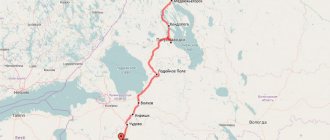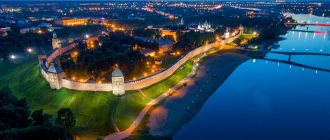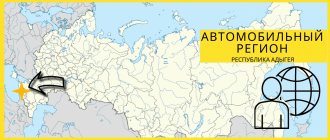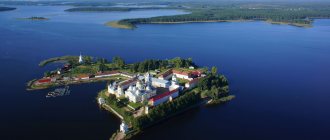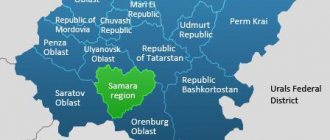Subjects of the Russian Federation
According to the Constitution of the Russian Federation, Russia is a federal state and consists of equal subjects of the Russian Federation (sometimes called simply “regions”), which are the basic territorial unit specified in the Constitution, and pertaining to all branches of government - executive, legislative, and judicial .
Most of the constituent entities of the Russian Federation are divided into administrative-territorial units, which mainly at the upper level include districts and cities that are not part of them - cities of regional (territorial, republican, district) significance , as well as in some regions closed administrative-territorial entities (for example in the Moscow region). The administrative-territorial structure of the constituent entities of the Russian Federation is established by the charters or constitutions of the constituent entities of the Russian Federation, regional laws of the constituent entities of the Russian Federation “On the administrative-territorial structure” and the corresponding registers of administrative-territorial units of the constituent entities of the Russian Federation. Within the framework of local self-government, they usually correspond to municipal entities with the status of a municipal district and a city or municipal district.
At the lower level of the administrative-territorial structure of the constituent entities of the Russian Federation, rural districts (village councils) or settlements , as well as rural settlements, urban-type settlements (working villages) and cities (of regional significance) and intra-city areas. Within the framework of local self-government, they usually correspond to municipalities with the status of a rural settlement or an urban settlement with their constituent settlements
The subjects of the federation are:
- republics
- the edges
- region
- federal cities
- Autonomous region
- autonomous okrugs.
Each of the types of subjects of the Russian Federation has its own constitutional and legal status, which is enshrined in the relevant articles of the Russian Constitution.
Currently, the Russian Federation includes 85 constituent entities, including: 22 republics, 9 territories, 46 regions, 3 federal cities, 1 autonomous region and 4 autonomous districts.
Republic of the Russian Federation
| № | Republic | Area (km2) | Administrative center |
| 1 | Republic of Adygea | 7792 | Maykop |
| 2 | Altai Republic | 92 903 | Gorno-Altaisk |
| 3 | Republic of Bashkortostan | 142 947 | Ufa |
| 4 | The Republic of Buryatia | 351 334 | Ulan-Ude |
| 5 | The Republic of Dagestan | 50 270 | Makhachkala |
| 6 | The Republic of Ingushetia | 3628 | Magas |
| 7 | Kabardino-Balkarian Republic | 12 470 | Nalchik |
| 8 | Republic of Kalmykia | 74 731 | Elista |
| 9 | Karachay-Cherkess Republic | 14 277 | Cherkessk |
| 10 | Republic of Karelia | 180 520 | Petrozavodsk |
| 11 | Komi Republic | 416 774 | Syktyvkar |
| 12 | Republic of Crimea | 20 081 | Simferopol |
| 13 | Mari El Republic | 23 375 | Yoshkar-Ola |
| 14 | The Republic of Mordovia | 26 128 | Saransk |
| 15 | The Republic of Sakha (Yakutia) | 3 083 523 | Yakutsk |
| 16 | Republic of North Ossetia–Alania | 7987 | Vladikavkaz |
| 17 | Republic of Tatarstan | 67 847 | Kazan |
| 18 | Tyva Republic | 168 604 | Kyzyl |
| 19 | Udmurt republic | 42 061 | Izhevsk |
| 20 | The Republic of Khakassia | 61 569 | Abakan |
| 21 | Chechen Republic | 15 647 | Grozny |
| 22 | Chuvash Republic | 18 343 | Cheboksary |
Territories of the Russian Federation
| № | The edges | Area (km2) | Administrative center |
| 1 | Altai region | 167 996 | Barnaul |
| 2 | Transbaikal region | 431 892 | Chita |
| 3 | Kamchatka Krai | 464 275 | Petropavlovsk-Kamchatsky |
| 4 | Krasnodar region | 75 485 | Krasnodar |
| 5 | Krasnoyarsk region | 2 366 797 | Krasnoyarsk |
| 6 | Perm region | 160 236 | Permian |
| 7 | Primorsky Krai | 164 673 | Vladivostok |
| 8 | Stavropol region | 66 160 | Stavropol |
| 9 | Khabarovsk region | 787 633 | Khabarovsk |
Regions of the Russian Federation
| № | Regions | Area (km2) | Administrative center |
| 1 | Amur region | 361 913 | Blagoveshchensk |
| 2 | Arhangelsk region | 589 913 | Arkhangelsk |
| 3 | Astrakhan region | 49 024 | Astrakhan |
| 4 | Belgorod region | 27 134 | Belgorod |
| 5 | Bryansk region | 34 857 | Bryansk |
| 6 | Vladimir region | 29 084 | Vladimir |
| 7 | Volgograd region | 112 877 | Volgograd |
| 8 | Vologda Region | 144 527 | Vologda |
| 9 | Voronezh region | 52 216 | Voronezh |
| 10 | Ivanovo region | 21 437 | Ivanovo |
| 11 | Irkutsk region | 774 846 | Irkutsk |
| 12 | Kaliningrad region | 15 125 | Kaliningrad |
| 13 | Kaluga region | 29 777 | Kaluga |
| 14 | Kemerovo region | 95 725 | Kemerovo |
| 15 | Kirov region | 120 374 | Kirov |
| 16 | Kostroma region | 60 211 | Kostroma |
| 17 | Kurgan region | 71 488 | Mound |
| 18 | Kursk region | 29 997 | Kursk |
| 19 | Leningrad region | 83 908 | Saint Petersburg |
| 20 | Lipetsk region | 24 047 | Lipetsk |
| 21 | Magadan Region | 462 464 | Magadan |
| 22 | Moscow region | 44 379 | Moscow |
| 23 | Murmansk region | 144 902 | Murmansk |
| 24 | Nizhny Novgorod Region | 76 624 | Nizhny Novgorod |
| 25 | Novgorod region | 54 501 | Velikiy Novgorod |
| 26 | Novosibirsk region | 177 756 | Novosibirsk |
| 27 | Omsk region | 141 140 | Omsk |
| 28 | Orenburg region | 123 702 | Orenburg |
| 29 | Oryol Region | 24 652 | Eagle |
| 30 | Penza region | 43 352 | Penza |
| 31 | Pskov region | 55 399 | Pskov |
| 32 | Rostov region | 100 967 | Rostov-on-Don |
| 33 | Ryazan Oblast | 39 605 | Ryazan |
| 34 | Samara Region | 53 565 | Samara |
| 35 | Saratov region | 101 240 | Saratov |
| 36 | Sakhalin region | 87 101 | Yuzhno-Sakhalinsk |
| 37 | Sverdlovsk region | 194 307 | Ekaterinburg |
| 38 | Smolensk region | 49 779 | Smolensk |
| 39 | Tambov Region | 34 462 | Tambov |
| 40 | Tver region | 84 201 | Tver |
| 41 | Tomsk region | 314 391 | Tomsk |
| 42 | Tula region | 25 679 | Tula |
| 43 | Tyumen region | 1 464 173 | Tyumen |
| 44 | Ulyanovsk region | 37 181 | Ulyanovsk |
| 45 | Chelyabinsk region | 88 529 | Chelyabinsk |
| 46 | Yaroslavl region | 36 177 | Yaroslavl |
Autonomous okrugs and autonomous region
| № | Autonomous okrugs and region | Area (km2) | Administrative center |
| 1 | Nenets Autonomous Okrug | 176 810 | Naryan-Mar |
| 2 | Khanty-Mansiysk Autonomous Okrug – Ugra | 534 801 | Khanty-Mansiysk |
| 3 | Chukotka Autonomous Okrug | 721 481 | Anadyr |
| 4 | Yamalo-Nenets Autonomous Okrug | 769 250 | Salekhard |
| 1 | Jewish Autonomous Region | 36 266 | Birobidzhan |
Federal cities
| № | Federal cities | Area (km2) | Administrative center |
| 1 | Moscow | 2511 | Moscow |
| 2 | Saint Petersburg | 1399 | Saint Petersburg |
| 3 | Sevastopol | 1080 | Sevastopol |
Map “Federal structure of Russia”
Migalkin, Federal structure of Russia, March 2014,
Grozny
Video: Grozny from above
History of Grozny
In 1818, Russian troops founded a fortress on the territory of the modern city to suppress the resistance of the highlanders who did not want to join Russia. Although many Caucasian peoples voluntarily entered into an alliance with their northern neighbor or were at least neutral towards it, the Chechens did not want to give up their freedom and for several decades raised regular uprisings. During this time, Lermontov managed to serve in the Grozny fortress, and Leo Tolstoy came here.
Grozny in 1995
Military operations ceased only in 1859, after which Terek Cossacks settled in Grozny and the surrounding area. The military significance of the fortress was lost, but at the end of the 19th century the city became a major industrial center of the Caucasus thanks to the discovery of oil deposits. After the revolution, during the Civil War, the city passed from hand to hand until it was finally occupied by the Red Army in 1920. The status of Chechnya changed, while Grozny remained an autonomous city. In 1936, it became the capital of the Chechen-Ingush Autonomous Soviet Socialist Republic. During the Great Patriotic War, fascist troops approached Grozny, but were stopped. During their retreat, they managed to set fire to the oil fields so that even the Sunzha River, on which the city stands, was on fire. Firefighters extinguished the flames at the cost of numerous casualties. In memory of their feat, a monument was erected in 1968 - the figure of a hero fighting fire, as if with a monstrous snake.
With the liberation of the Caucasus, the hardships of the Grozny residents did not end: on February 23, 1944, the entire people were deported to Central Asia and Kazakhstan. The Chechens were rehabilitated and Grozny was returned to the status of the capital of the Chechen-Ingush Autonomy only in 1957. In 1991, after the division of Chechnya and Ingushetia, Grozny remained the capital of the first of the two republics. In 1994, the First Chechen War began; during the assault on Grozny, which lasted until March 1995, the city center was completely destroyed, and other parts were also very badly damaged. Bombings were repeated in 1999 during the Second Chechen War.
Since the beginning of the 2000s, the restoration of Grozny began. The construction of socially significant facilities continues to this day.
Grozny at night
Architectural sights of Grozny
Grozny is the center of the world
For historical reasons, most of the sights of the Chechen capital were built in the last decade. There are about 4 dozen fountains in Grozny, many of them are simply a vertical stream of water, but there are also unusual ones. Among the interesting ones is the musical fountain of Vladimir Putin, opened in 2010 on his birthday. The “Waterfall” near the Grozny City complex is a cascade of water that you can look at almost closely from a wooden bridge. “Running Wave” with illumination is open near the “Heart of Chechnya”. Grozny has its own Triumphal Arch, or more precisely, these are two arches standing next to each other with Vainakh towers at the edges, symbolizing the unity of Russia and Chechnya. Colorful steles are dedicated to the geographical location of the city: on the Garden Ring, based on the state symbols of Chechnya, there is a globe surrounded by the inscription “Grozny - the center of the world.”
Memorial to the Victims of Deportation
One of the most touching monuments, which has stood on Ali Mitaev Street since 1994, on the site of historical burials of Chechens, is now being moved to a new location. This sculptural image of a raised hand with a sword, surrounded by dozens of gravestones collected from all over the republic, is a symbol of grief and eternal memory of those killed during the expulsion from Chechnya.
Mosque "Heart of Chechnya"
Founded in 2006 and opened to the public in 2008, the Heart of Chechnya mosque has become one of the largest in the world. In the center of the building there is a massive dome 32 m high, surrounded by 4 minarets 63 m high. The walls are faced with marble and travertine. Specialists from Turkey were invited to Grozny to paint the walls with Chechen ornaments. Numerous gilded chandeliers symbolize the most important mosques of the Muslim world - the Dome of the Rock in Jerusalem, Rovzatu Nebevi in Medina and the main shrine of Islam - the Kaaba of Mecca. 10 thousand people can pray in the Grozny mosque at the same time, and the square in front of the building and the summer gallery can accommodate the same number.
Mosque "Heart of Chechnya"Grozny-City"
The grandiose project “Grozny-City-1” involved the construction of high-rise buildings on Akhmat Kadyrov Avenue. The complex included residential buildings, a hotel, an office building, and a shopping center. The second stage, “Grozny-City-2”, is even more majestic, since its sponsors were Arab sheikhs. The main building is the Akhmat Tower, a more than 100-story building, the future European record holder in terms of number of floors. Its total height will be 435 meters - given the high seismicity of Grozny, this is a very difficult task for an architect. The building is multidisciplinary: it will house apartments, offices, restaurants, the Akhmat Kadyrov Museum, a sports complex and a swimming pool, a hotel, and conference rooms. The gigantic building, the prototype of which was the Chechen ancestral tower, will be served by 20 high-speed elevators. While the project is at the foundation stage, it is stated that construction costs are already at least 2 times higher than the estimated figures.
Grozny City
Museums of Grozny
A significant part of the cultural heritage of Chechnya, stored in the museums of the capital, was lost under shelling. Exhibits for new museums are brought from other regions of the country or received as gifts from individuals. The main part of the exhibitions is related to the history of the republic, the wars in which the Chechens participated, and the personality of Akhmat-Khadzhi Kadyrov, the father of the current head of Chechnya and its first legitimate president, who died as a result of a terrorist attack in 2004.
National Museum
The National Museum of Grozny, founded in 1924, has almost no historical exhibits left. During the wars, the ethnographic collection was lost, valuable paintings by Vereshchagin, Roubaud, and Aivazovsky were lost. In 2007, the renovated museum was opened, the funds were increased through donations, restoration and the discovery of missing exhibits. In 2012, the museum moved to a new building. The archaeological department contains artifacts found on the territory of the republic. The department of decorative and applied arts presents an interesting collection of folk instruments and traditional ceramics, and the ethnographic department contains household items and clothing. Among the valuable items are bladed weapons that belonged to the heroes of the Chechen people who lived in the 19th and early 20th centuries. A separate hall is dedicated to the memory of Akhmat Kadyrov. Ticket price is 100 rubles, for schoolchildren, students and pensioners – 50 rubles. There is a fee for photography. The museum is open from 10 to 17.30 with a break from 13 to 14. Closed on Monday.
Museum of Akhmat-Khadzhi Kadyrov
The Kadyrov Glory Complex became the third largest in the country, second only to Mamayev Kurgan and Poklonnaya Hill. Busts of World War II heroes, natives of Chechnya, an equestrian monument to Movladi Visaitov, commander of cavalry regiments, and military equipment of this period are located here. The golden dome at the entrance to the Kadyrov Museum is crowned by a 40-meter spire-stele decorated with the Order of Victory. The Eternal Flame burns in front of him.
The newly opened 4-level museum amazes with its luxury. Marble from Spain was ordered to finish the floor, and a one and a half ton chandelier made in Iran was covered with gold. 750 light bulbs shine in it at the same time. The interior of the building is eclectic: twisted columns are designed in the Moroccan style, the dome is decorated with white stucco with elements of the Chechen national ornament, and the golden stucco ceiling is reminiscent of the palaces of French kings. Kadyrov’s carefully reproduced office contains his personal belongings and state awards. In the halls of the museum on the second floor there is an art gallery, where some of the 500 paintings donated to Chechnya by artists from the country are exhibited. The museum is open from 10 a.m. to 5 p.m. daily, except Wednesdays, with a break from 1 p.m. to 2 p.m.
Sports Grozny
The famous Terek, recently renamed Akhmat, is based at the Akhmat Arena stadium, which seats 30 thousand spectators. In addition to football, Grozny residents also promote other sports. In 2015, the Fortress Grozny circuit opened, hosting international competitions. Several tracks for various types of auto and motorcycle racing are built on the territory of a former oil refinery. Professional and amateur events can be watched by 1,600 spectators simultaneously. From 10 a.m. to 10 p.m. in summer, you can rent karts at the race track. The cost of a 10-minute ride is 350 rubles for children, 500-700 rubles. – for adults.
Beaches and parks of Grozny
In Grozny there are both exemplary parks and those that have not yet been touched by restorers, such as the park of Lenin or Musorov, a figure from the Civil War. Against this background, Kadyrov Park looks much more attractive with ideal lawns, streams, new attractions and clean cafes. Next to it is a zoo, at the entrance to which there is a stone slide with an observation deck at the top. Several enclosures at the zoo contain a tiger, a family of lions, a bear, and a wolf. For family time, Grozny residents choose the Mother's Glory Park, full of attractions, or Journalists' Square, a large shady boulevard with fountains for evening walks.
Streets of GroznyGrozny Sea
The Chernorechenskoe reservoir was built in Grozny back in 1961. In 2012, its surroundings began to be transformed into a modern recreational area. Currently, construction is underway here of a fashionable hotel and a multi-storey restaurant in the form of a medieval tower, a sports training facility with accommodation for athletes and coaches, and the Aqua complex for family recreation. The world's largest color and musical fountain has already been launched, measuring 300 by 40 m and with jets up to 100 m high. Any video can be shown on the screens created by the jets. The lighting is controlled by 3,600 spotlights.
In 2015, two sections of the beach were opened on the Grozny Sea - for men and for women, separated by a distance of 2 km and a high fence. Until this time, swimming in public places was a problem for women - they had to remain in closed clothes or in rather expensive special swimsuits for Muslim women. Now they are not afraid of unwanted attention: only boys under 12 years old can enter women’s territory, even lifeguards on the beach - and even those women. The beaches on the Chernorechensky reservoir are sandy; sand and shells were brought from the Caspian Sea. Entrance to the territory is paid.
Holiday "Day of Peace in the Chechen Republic"
Tourist information
Summers in Grozny are hot and dry, winters are usually mild, but temperatures can drop to -20 °C due to cold northern winds.
There is an unspoken dress code in the republic that recommends that women cover their knees and not wear trousers, much less tight jeans, T-shirts, transparent blouses, or low necklines. It is generally better to walk the streets accompanied by a man. You need to carry a scarf with you so that you can wear it when necessary - when going to a mosque or government agency. Men shouldn’t relax either: even in the summer heat, you can’t wear shorts or T-shirts. In mosques it is mandatory to take off your shoes when entering.
Transport in Grozny
The main public transport in the Chechen capital is suburban and city buses. You can order an inexpensive taxi or catch a private taxi driver. Despite the presence of a railway, there are no electric trains. When driving on your own, you need to keep in mind that pedestrians in Grozny often cross the road where it is convenient for them, and not at a traffic light, and some drivers forget about the red light.
Where to stay
Renting an apartment for a few days or staying in a hotel room of any price category in Grozny is not problematic - there are always enough free places. The cost of living in a standard room or one-room apartment is 1500-2000 rubles per day, although this is far from the limit. “Grozny City” rents rooms with lush decoration and air conditioning for 7,000-16,000 rubles per day at the height of the season; in winter, prices are about 15% lower. The less pompous Continent Hotel, located 3 km north of Grozny's main attractions, costs about 4,000 rubles per room with breakfast.
Booking.com
How to get there
Intercity buses go to Grozny from Moscow, Yaroslavl, Astrakhan, Elista, Nevinnomyssk, and there is an international route from Baku. Flights from Moscow, Bishkek and Istanbul arrive at Grozny Airport, on the northern borders of the city. In the future, there is the modernization of the runway to be able to accommodate the most spacious aircraft, the construction of a 5-star hotel near the airport and the expansion of flight geography. You can get to Grozny by train from Moscow and Volgograd.
Calendar of low prices for air tickets
Federal districts
Federal districts of the Russian Federation were created in accordance with Decrees of the President of Russia.
The Federal District of Russia is not a subject of the federation or any constitutional part of the administrative-territorial division of the Russian Federation. The plenipotentiary representative of the President of the Russian Federation in the federal district does not have any constitutional powers - he is a representative of the President and an employee of the Presidential Administration.
| County name | Administrative center | Number of subjects of the Russian Federation | Area (thousand km2) |
| Central Federal District | Moscow | 18 | 652, 8 |
| Southern Federal District | Rostov-on-Don | 6 | 416, 84 |
| Northwestern Federal District | Saint Petersburg | 11 | 1 677, 9 |
| Far Eastern Federal District | Khabarovsk | 9 | 6 215, 9 |
| Siberian Federal District | Novosibirsk | 12 | 5 114, 8 |
| Ural federal district | Ekaterinburg | 6 | 1 788, 9 |
| Volga Federal District | Nizhny Novgorod | 14 | 1 038 |
| North Caucasus Federal District | Pyatigorsk | 7 | 172, 36 |
Classification of territorial entities
OKATO contains codes and names of objects of administrative-territorial division of the constituent entities of the Russian Federation: from districts and cities to intra-city areas, rural districts (village councils) and populated areas.
OKTMO contains codes and names of municipalities of the constituent entities of the Russian Federation: from municipal districts and urban districts to rural and urban settlements, as well as their constituent settlements.
The All-Russian Classifier of Objects of Administrative-Territorial Division (abbreviated OKATO) is a classifier of objects of administrative-territorial division of the Russian Federation, part of the “Unified System of Classification and Coding of Technical, Economic and Social Information of the Russian Federation” (ESKK). OKATO is designed to ensure reliability, comparability and automated processing of information across administrative and territorial divisions in such areas as statistics, economics and others.
Official page of the OKATO classifier
protect.gost.ru
OKATO with the ability to search by name or part of the number in the classifier
archive.is
Determine OKTMO according to OKATO
kod-x.ru/polza
The All-Russian Classifier of Municipal Territories (abbreviated OKTMO) is a classifier of objects of the administrative-territorial division of the Russian Federation, part of the “Unified System of Classification and Coding of Technical, Economic and Social Information of the Russian Federation” (ESKK).
OKTMO consists of two sections, including municipalities and settlements that are part of municipalities.
The formula for the structure of the OKTMO code in the first section (8 characters): XX XXX XXX, where: 1, 2 characters identify classification objects of the first classification stage; 3 - 5 signs identify objects of classification of the second stage of classification; 6 - 8 signs identify objects of classification of the third level of classification.
The formula for the structure of the OKTMO code in the second section (11 characters): XX XXX XXX XXX, where: 1 - 8 characters identify municipalities that include settlements; 9 - 11 signs identify settlements.
OKTMO on the Rosstat website
www.gks.ru/method
Information about the all-Russian classifier codes established for business entities, including OKTMO codes, is posted on the Rosstat Internet portal at: websbor.gks.ru/online
Service for searching for the code of a municipality or locality using OKTMO
www.oktmo.ru
The service is intended for contextual search of the code of a locality or code of a municipal entity of a constituent entity of the Russian Federation. The inverse problem is also solved: searching for an object using a known code or part of the OKTMO code (OK 033–2013).
A little about the modern Chechen capital
A fifth of the total population of the republic is concentrated in Grozny - about 21%. Therefore, it is not surprising that this city is also the center of cultural life of the entire region. Thus, the largest universities in Chechnya are located in Grozny - Chechen State University, Grozny State Petroleum Technical University named after. Academician M.D. Millionshchikov and the Chechen State Pedagogical Institute. And also the Grozny Russian Drama Theater named after. M.Yu, Lermontov, Chechen State Drama Theater named after. Nuradilov, the State Symphony Orchestra of the Chechen Republic, the Chechen State Philharmonic, the National Library of the Chechen Republic and the National Museum of Chechnya are based in Grozny.
The following sights of Grozny are memorable for residents of the city, and also interesting for tourists who come to the city - Memorial to the Heroes of the Great Patriotic War, an impressive monument to Mikhail Yuryevich Lermontov, an interesting Monument to Journalists who died for freedom of speech, Monument to Grozny Women, Monument to Mothers, Sculpture of Grozny firefighters and many others. Residents of Grozny are proud of their city, which over the past few decades has been literally restored from ruins.
